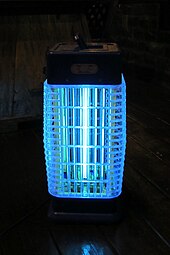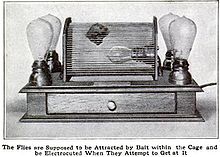Electric insect killer
An electric insect killers is attract a device that flying insects by means of a light source and by means of an under voltage to kill standing metal net.
history
In October 1911, Popular Mechanics magazine featured a prototype electric insect killer.
According to the US Patent and Trademark Office , the first electric insect killer was patented by William M. Frost in 1932 .
construction
Modern electric insect killers are usually installed in a protective plastic cage or in a grounded metal cage in order to prevent users from coming into contact with the live metal network. The German regulations for electrical appliances stipulate safe contact protection, which makes this cage necessary, but also prevents very large insects from entering. Inside there is often a special fluorescent tube as a light source that emits a high proportion of UV light that is visible to flying insects and is intended to attract them.
The lamp is surrounded by a metal wire mesh. In this the respective adjacent wires are electrically insulated from each other and to a voltage of about 1000 V connected. If an insect comes to this grid, it touches the two wires of the grid with its body and thus briefly closes the circuit . The electricity flowing through the body as a result kills the insect. Many electric insect killers have a shallow bowl at the bottom in which the killed insects can be collected and removed easily.
variants
A variant of the electric insect killer is the electric fly swatter . It is a device shaped like a tennis racket that also kills the insects with an electric shock, but does not attract them.
Alternative methods
There are many alternatives for killing or driving away pesky insects. One option is to use repellents , such as B. Icaridin or diethyltoluamide (DEET) to drive away insects.
criticism
If the device is used outdoors, the number of mosquitoes that are killed by the trap is very low compared to other flying insects that are actually not the target of the device. Mosquitoes are not only attracted by light, but mainly by the carbon dioxide and water vapor in the breath of mammals. The light attracts many insects that would otherwise not be there. These can be ecologically valuable, e.g. B. as a pollinator of plants. In Germany, the use of such electrical insect killers outdoors is therefore prohibited under Section 44 of the Federal Nature Conservation Act in conjunction with Section 4 of the Federal Species Protection Ordinance.
The electrical voltage that is supposed to kill the animals often only works with smaller insects. With larger ones, however, often only the wings are burned, which can mean a long agony for them.
The Naturschutzbund Deutschland (NABU) started a protest e-mail campaign with 1330 participants against electric insect killer lamps. Slightly more than half of the companies contacted then removed devices for outdoor use from their range or insured that they would point out the ban on outdoor use with additional product descriptions.
Web links
Individual evidence
- ↑ An electric death trap for the fly. In: Popular Mechanics . October 1911, p. 464 ( digitized from Google Books, English).
- ^ Insect electrocutor. In: Google Patents. Retrieved July 4, 2019 .
- ↑ a b How exactly do insect killers work? In: Fly screen and Insect protection.de. Retrieved July 4, 2019 .
- ↑ Can mosquitoes be repelled with UV lamps? In: t-online.de. June 1, 2016, accessed July 4, 2019 .
- ↑ NABU: Use of insect lamps outdoors is prohibited. In: Presseportal.de. July 25, 2012, accessed July 4, 2019 .
- ↑ Positive conclusion of the protest action. In: NABU.de. Retrieved July 4, 2019 .


